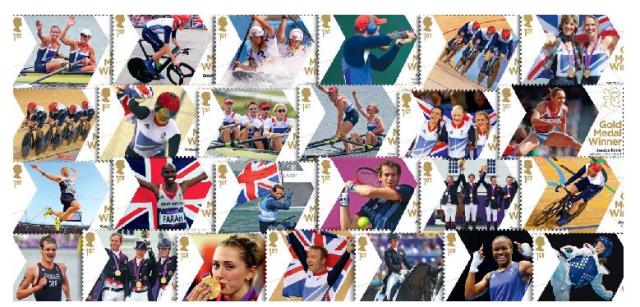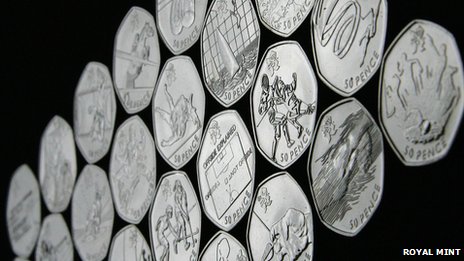London 2012 Olympics
Do you own a scarce Olympic 50p?

Which Olympic 50p coins are most scarce?
29 million Olympic 50p coins have been released into circulation by the Royal Mint and, as already reported, as many as 75% have been removed from circulation.
But as collectors strive to build and that complete collection of all 29 50p coins, they are discovering that some sports are more elusive than others.
The launch of The Westminster Collection’s FREE online Olympic 50p Swap Centre has revealed which Olympic coins are top of the scarcity charts, with the most collectors listing them on their “Want List”.
So let’s find out – do you own of the scarce ones?
The most requested 50p coins…
- Football
- Handball
- Wrestling
- Judo
- Cycling

The Football Olympic 50p Coin has been the most requested coin on collectors’ “Want Lists”
So whether you are in possession of one of the more sought after 50p coins and are able to swap it, or if you are still trying to find that elusive missing piece, try the FREE Olympic 50p Swap Centre.
Simply register online and list the coins you need before entering any swaps you have. Click “search” and you will be able to view your SWAP MATCHES and make contact. All totally for FREE.
New Paralympic stamps revealed by Royal Mail
 The Royal Mail has today announced plans to issue an extra set of stamps to mark the 2012 Paralympic Games.
The Royal Mail has today announced plans to issue an extra set of stamps to mark the 2012 Paralympic Games.
The set of four stamps will feature the Paralympic sports of wheelchair basketball, cycling, powerlifting and athletics alongside famous London landmarks such as St Paul’s Cathedral. They will go on sale on 29th August to coincide with the start of the games in London, Royal Mail confirmed today.
This new set is in addition to the stamps already announced by Royal Mail to mark each Paralympic gold medal. During London 2012, the Royal Mail issued a new stamp to mark each of the twenty-nine gold medals won by Team GB.
Similarly, the Royal Mail will also paint the post box gold in each home town of a gold medal winning Paralympian, just as it did for London 2012.
“We hope these stamps will help get the nation excited about the Paralympic Games and encourage the public to support Paralympics GB when it’s our turn to compete against the best in the world,” says Tim Hollingsworth, Chief Executive of the British Paralympic Association.
The Paralympics have grown significantly since the first games in Rome in 1960 when just 400 athletes from 23 countries participated in wheelchair sports only. This year, London will play host to over 4,200 Paralympians from around 150 countries who will take part in a total of 20 sports. These range from popular disciplines such as athletics, sailing and rowing to the less well-known boccia and goalball.
As the athletes start to arrive in the Capital to complete their preparation, the Paralympic torch began its week-long journey on Wednesday 22nd August. This will culminate in a 24-hour relay from Stoke Mandeville, the birthplace of the Paralympic movement, to the Olympic Stadium, the site of the Opening Ceremony.
At the Paralympics in Beijing in 2008, the British team won 42 gold medals. The games run until 9th September.
The Olympic Legacy – a collector’s Games…

A new Royal Mail Stamp for every Gold Medal Winner
– just one of the moments that made the Olympics a collector’s Games
23 million of us watched with a touch of sadness as the Olympic Flame was extinguished on Sunday night. As the flame died away, a giant Phoenix rose above the cauldron almost asking the question of what legacy will rise from the ashes of this great event.
Of course, there has been much coverage of how the Olympics will leave a sporting legacy for the United Kingdom but what of its collecting legacy?
January 1999 – an event that changed coin collecting forever
In January 1999 an event changed the coin collecting market forever – in the United States the first State Quarter was issued. It marked the beginning of a 50 coin programme that placed a quarter for every US State into circulation. Average annual quarter mintages reached 3.5 billion pieces – 135% more than the previous average pointing to the vast numbers of coins being collected out of circulation.
The legacy has been at the heart of a revitalised United States numismatic market that continues to see new mintages – often as high as 500,000 – repeatedly oversubscribed and a continued strengthening of the secondary market.
Our “State Quarter Moment”
The Olympics has provided the UK with its own State Quarter moment through the 29 Olympic Sports 50 pence coins, which have been released into circulation. Not even the Royal Mint would suggest that the Olympic 50p coins have had the same impact as the US State Quarters but over the weeks leading up to and during the Games, they have seen increasing popular interest amongst the man, woman and child on the street.
Previously few people took more than a passing glimpse at their change (even though a number of different £2, £1 and 50p designs exist) but suddenly you see children begging parents of “that 50p”; waitresses wanting to swap the coins in their tips; people turning to social media to requests swaps of their duplicated coins.
The collecting fever that so often has been seen in the playgrounds of the country for Pokemon cards or Panini World Cup stickers is being repeated across the country, not just amongst kids but by adults of all ages.
With the success of the Games, the upcoming Paralympic frenzy and the increasing rarity of the circulating Olympic 50 pence coins, the collecting fervour of the British nation looks set to continue.
“We’re going to be on a stamp tomorrow”
If the 50 pence series started to capture a nation in the lead up to the Games, nothing compares to the excitement that Royal Mail’s Olympic offering has provided.
When almost the first thing an Olympian says on winning a gold medal is “We’re going to be on a stamp tomorrow”, you know that Royal Mail’s decision to issue Gold Medal winners stamps is a good one. Well that is exactly what Kat Copeland said to her Double Skulls partner, Sophie Hosking just moments after completing their epic Gold Medal winning competition.
And what a collection of stamps Royal Mail has gone on to produce, featuring all 29 Gold Medals and 42 Olympians, in a massive logistical feat each stamp was available the very next day from 500 Post Offices across the country.
Royal Mail successfully engaged a nation, with athletes being presented with blow ups of their stamps during TV interviews and the national newspapers providing consistent coverage.
The result has been a series of stamps that has seen more interest from the public than anything else since the very first stamps of Queen Elizabeth II – something that is beyond most of the population’s living memory.
So what of the legacy?
The Games have created thousands of new collectors. Some will stop but many others will continue. Some already are, choosing to select some of the more limited edition coins and stamps available to celebrate the Games.
Whatever their choice, those people who have stepped into the world of coins or stamps, perhaps for the first time, own a collectable for the future.
In years to come, children and grandchildren will look, touch and feel that moment when Great Britain held the Olympic Games. It will be the closest they get to being able to share the sense of achievement we have all felt over the last two weeks – a true sense of Great Britishness.
As such they create the sort of emotional value that so often forms the basis of a longer term physical value. Today’s mementos of a magnificent Games will represent a moment of history for future generations. By the time Britain hosts the Games again these will be the stuff of the Antiques Roadshow.
A Legacy for sport – we all hope so. A Legacy for collecting – without doubt.
For more information or to buy Olympic Stamps and Coins, click here





